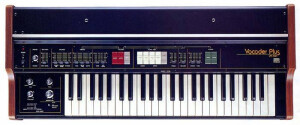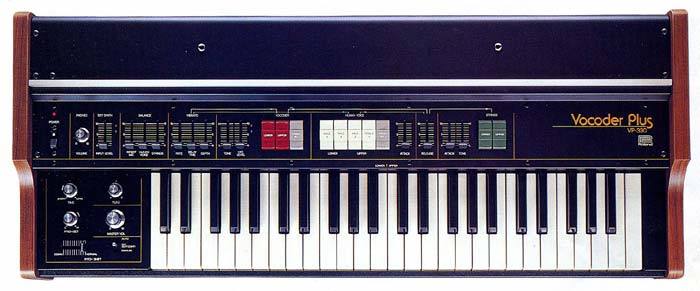View other reviews for this product:
« Superb vintage vocoder »
Published on 03/27/11 at 11:50(Note: I have the MkII version)
4 octave keyboard without velocity or aftertouch, but beautiful large black and white keys enjoyable nonetheless.
Three sections (Vocoder, Strings, and Human Voice) simultaneously, in split (2 + 2 octaves) or overlay with adjustable levels for each part.
Connectors simple stereo output, microphone input (XLR and Jack are available) with an opportunity to hear the voice direct input for external synthesizers used carrier for the vocoder.
There are 2 entries for "Control" for the pitch and the "vocoder hold", I do not use. And a headphone output.
UTILIZATION
Using fairly simple without a manual. Everything is there, under the eyes. A bit of haggling early enough to operate the machine to its full potential, then it is the musician's imagination takes over.
SOUNDS
The sound is very distinctive, but sublime.
The section "Strings" has a permanent chorus (you can dispose of them out in mono), a tone control (a kind of low pass filter), adjusting attack and release. It is a purely synthetic sound in the style of an ARP Solina but his own character (and a few parameters String synthesizer "dedicated).
The section "Human Voice" has 2 different sounds, stacked or splitables (which actually sounds are the same but shifted by one octave), a customizable vibrato and an overall effect (chorus). The setting is shared with the Release section Strings. The sound is rather poor without the Ensemble effect, but becomes sublime when it is engaged. Again, no realism to the horizon, it looks like voices from outer space.
The Vocoder section shares most of the settings in "Human Voice", but has an independent effect of Ensemble, and a tone control.
This is the part that vocoder made me buy, and I'm not disappointed. I had an Alesis Ion, which has a Vocoder really poor, and there is totally incomparable.
VP330 with one understands what is said, we use the internal source or an external source such as a carrier. There is no definable bands, but the tone control overcomes this lack to some extent.
OVERALL OPINION
I use this synth since February 2011, and we're late March at the time of writing. I repeatedly asked if its owner does not wish to sell it, until one day he decided. I knew the craft of reputation, but the demos YouTube (despite their mediocrity) and a loan of two weeks have finally convinced me to buy it.
I'm using it on demo recordings of my band (mix of rock, pop, progressive, metal) and I intend to use it for my personal project which will include more than synthetic sounds, but always in a context pop / rock (I also do guitar and vocals). As a fan of JM Jarre and Vangelis, I love the synth sounds "old school".
What I love is its unmistakable vintage sound and intelligible side of the Vocoder.
What I like least is the fragile side due to his age ... I do not plan to use it in concert, I'll look for an alternative when the time comes (style Korg R3), even if it means losing a little quality vocoder.
A previous review mentioned the problem of the envelope (attack and release) is not polyphonic. This is an important feature of the instrument, I do not find annoying for me. The result is that the attack will only affect the first notes played as long as we maintain at least one button, and release back sharply to zero when playing a new note after them all released. I walk around this problem ... using another synth for layers!
4 octave keyboard without velocity or aftertouch, but beautiful large black and white keys enjoyable nonetheless.
Three sections (Vocoder, Strings, and Human Voice) simultaneously, in split (2 + 2 octaves) or overlay with adjustable levels for each part.
Connectors simple stereo output, microphone input (XLR and Jack are available) with an opportunity to hear the voice direct input for external synthesizers used carrier for the vocoder.
There are 2 entries for "Control" for the pitch and the "vocoder hold", I do not use. And a headphone output.
UTILIZATION
Using fairly simple without a manual. Everything is there, under the eyes. A bit of haggling early enough to operate the machine to its full potential, then it is the musician's imagination takes over.
SOUNDS
The sound is very distinctive, but sublime.
The section "Strings" has a permanent chorus (you can dispose of them out in mono), a tone control (a kind of low pass filter), adjusting attack and release. It is a purely synthetic sound in the style of an ARP Solina but his own character (and a few parameters String synthesizer "dedicated).
The section "Human Voice" has 2 different sounds, stacked or splitables (which actually sounds are the same but shifted by one octave), a customizable vibrato and an overall effect (chorus). The setting is shared with the Release section Strings. The sound is rather poor without the Ensemble effect, but becomes sublime when it is engaged. Again, no realism to the horizon, it looks like voices from outer space.
The Vocoder section shares most of the settings in "Human Voice", but has an independent effect of Ensemble, and a tone control.
This is the part that vocoder made me buy, and I'm not disappointed. I had an Alesis Ion, which has a Vocoder really poor, and there is totally incomparable.
VP330 with one understands what is said, we use the internal source or an external source such as a carrier. There is no definable bands, but the tone control overcomes this lack to some extent.
OVERALL OPINION
I use this synth since February 2011, and we're late March at the time of writing. I repeatedly asked if its owner does not wish to sell it, until one day he decided. I knew the craft of reputation, but the demos YouTube (despite their mediocrity) and a loan of two weeks have finally convinced me to buy it.
I'm using it on demo recordings of my band (mix of rock, pop, progressive, metal) and I intend to use it for my personal project which will include more than synthetic sounds, but always in a context pop / rock (I also do guitar and vocals). As a fan of JM Jarre and Vangelis, I love the synth sounds "old school".
What I love is its unmistakable vintage sound and intelligible side of the Vocoder.
What I like least is the fragile side due to his age ... I do not plan to use it in concert, I'll look for an alternative when the time comes (style Korg R3), even if it means losing a little quality vocoder.
A previous review mentioned the problem of the envelope (attack and release) is not polyphonic. This is an important feature of the instrument, I do not find annoying for me. The result is that the attack will only affect the first notes played as long as we maintain at least one button, and release back sharply to zero when playing a new note after them all released. I walk around this problem ... using another synth for layers!




